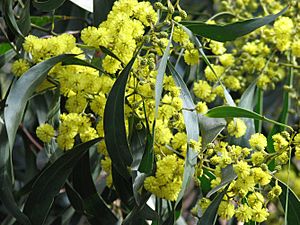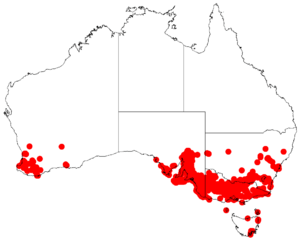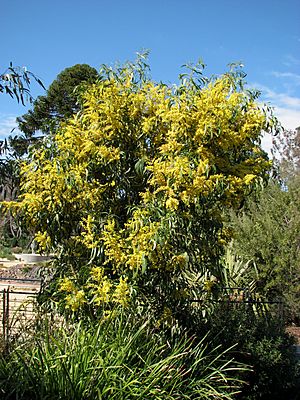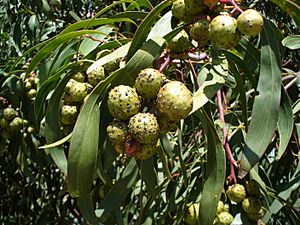Golden wattle facts for kids
Quick facts for kids Golden wattle |
|
|---|---|
 |
|
| Scientific classification | |
| Genus: |
Acacia
|
| Species: |
pycnantha
|
 |
|
| Occurrence data from AVH | |
| Synonyms | |
|
Species synonymy
Acacia falcinella Meisn.
Acacia petiolaris Lehm. Acacia pycnantha var. petiolaris H.Vilm. Acacia pycnantha Benth. var. pycnantha Acacia westonii Maiden Racosperma pycnanthum (Benth.) Pedley |
|
The golden wattle (scientific name: Acacia pycnantha) is a beautiful tree from the pea family, Fabaceae. It is native to southeastern Australia. This tree can grow up to 8 meters (26 feet) tall. Instead of true leaves, it has flattened leaf stalks called phyllodes. These are shaped like sickles and are about 9 to 15 cm (3.5 to 6 inches) long.
In late winter and spring, the golden wattle bursts with many fragrant, golden flowers. After the flowers, long seed pods grow. Birds like honeyeaters and thornbills help pollinate the flowers. They visit special spots on the phyllodes that produce nectar. As they feed, they brush against the flowers, moving pollen from one plant to another. The golden wattle grows in the understorey (the layer of plants below the main canopy) of eucalyptus forests. You can find it in southern New South Wales, the Australian Capital Territory, Victoria, and southeastern South Australia.
The explorer Thomas Mitchell first collected a sample of this plant. Based on his sample, George Bentham officially described the species in 1842. The bark of the golden wattle produces more tannin than any other wattle species. Tannin is a substance used in leather making. Because of this, the tree is grown commercially. It is also a popular garden plant and is grown for cut flowers. However, it has become a weed in some parts of the world, including South Africa and New Zealand. In 1988, Acacia pycnantha became the official floral emblem of Australia. It has even appeared on Australian postal stamps!
Contents
What the Golden Wattle Looks Like
The golden wattle usually grows as a small tree. It reaches about 3 to 8 meters (10 to 26 feet) tall. Some trees in Morocco have been reported to be as tall as 12 meters (39 feet). The bark is usually dark brown to grey. On younger trees, it is smooth, but on older trees, it can be rough and furrowed.
Mature golden wattle trees do not have true leaves. Instead, they have phyllodes. These are flat, widened leaf stems that hang from the branches. They are shiny and dark green. Each phyllode is about 9 to 15 cm (3.5 to 6 inches) long and 1 to 3.5 cm (0.4 to 1.4 inches) wide. They are often shaped like a sickle. New growth on the tree has a bronze color.
Flowers and Seeds
The golden wattle produces flower buds all year round. However, only those that start growing between November and May will bloom later. The tree usually flowers from July to November. This is late winter to early summer in Australia. The bright yellow flowers grow in groups of 40 to 80. These groups are on stalks that are 2.5 to 9 cm (1 to 3.5 inches) long. Each flower group is a ball-like shape. It is covered with 40 to 100 tiny flowers. These small flowers have five tiny petals and long, upright stamens. This gives the flower head a fluffy look.
After the flowers finish blooming, seed pods start to grow. These pods are flat and can be straight or slightly curved. They are about 5 to 14 cm (2 to 5.5 inches) long and 5 to 8 mm (0.2 to 0.3 inches) wide. At first, they are bright green, but they turn dark brown as they ripen. The pods have slight pinches between the seeds. The seeds are arranged in a line inside the pod. They are black, shiny, and about 5.5 to 6 mm (0.2 inches) long. The seeds are released in December and January when the pods are fully ripe.
Similar Plants
Some other wattle species look similar to the golden wattle. These include the mountain hickory wattle (A. obliquinervia), coast golden wattle (A. leiophylla), and golden wreath wattle (A. saligna). Each has small differences in their phyllodes or seed pods.
How the Golden Wattle Got Its Name
The golden wattle, Acacia pycnantha, was first officially described by a botanist named George Bentham in 1842. He wrote about it in the London Journal of Botany. The sample he used was collected by explorer Thomas Mitchell in what is now northern Victoria.
The name pycnantha comes from two Greek words: pyknos, meaning "dense," and anthos, meaning "flower." This name refers to the dense clusters of flowers that make up the golden wattle's round flower heads.
Over time, some botanists tried to give it other scientific names. For example, Les Pedley tried to rename it Racosperma pycnanthum in 2003. However, its original name, Acacia pycnantha, is still the one used today. The common names for this tree include golden wattle, green wattle, black wattle, and broad-leaved wattle.
Where the Golden Wattle Grows
The golden wattle grows naturally in southeastern Australia. You can find it from southern Eyre Peninsula and Flinders Ranges in South Australia, across Victoria, and north into southern New South Wales and the Australian Capital Territory. It prefers dry, shallow soils and grows in the understorey of open eucalypt forests.
The species has also spread beyond its natural home in Australia. In New South Wales, it is common around Sydney. In Tasmania, it has become a weed in some bushland areas. In Western Australia, it is found in several regions.
Outside Australia, the golden wattle has become naturalized in many countries. These include South Africa, Tanzania, Italy, Portugal, India, Indonesia, and New Zealand. In South Africa, it was brought in between 1858 and 1865 to help stabilize sand dunes and produce tannin. However, it spread into forests and other natural areas. To control its spread, scientists introduced a special wasp called Trichilogaster signiventris. This wasp forms galls (abnormal growths) in the flower heads, which stops the trees from making seeds. Another insect, the acacia seed weevil Melanterius compactus, was also introduced in 2001 and has helped control the plant.
Golden Wattle in Nature
Golden wattle plants are usually killed by severe fires. However, mature trees can sometimes resprout (grow back) after a fire. The seeds can stay in the soil for more than five years and will sprout after a fire.
Nitrogen Fixation
Like other wattle trees, the golden wattle helps to fix nitrogen from the air. It does this with the help of special bacteria called rhizobia. These bacteria live in small bumps on the tree's roots called nodules. There, they turn nitrogen into a form the plant can use. This helps the golden wattle grow well even in poor soils.
Pollination and Life Cycle
The golden wattle cannot fertilize itself. It needs pollen from another golden wattle plant to make seeds. Birds play a big role in this pollination. If birds are kept away from the flowers, much fewer seeds are produced. The phyllodes have special spots called nectaries that produce sweet nectar. Birds feed on this nectar, especially when the flowers are open. As they feed, they brush against the flower heads, picking up pollen. They then carry this pollen to other trees.
Several types of honeyeaters, like the white-naped, yellow-faced, and New Holland honeyeaters, have been seen feeding on golden wattle. Other birds like silvereyes and thornbills also visit. Besides nectar, birds often eat insects found on the leaves. Honeybees, native bees, ants, and flies also visit the nectaries.
Insects and Fungi
The wood of the golden wattle is food for the larvae (young) of certain jewel beetle species. The larvae of several butterfly species also eat the foliage. Trichilogaster wasps create galls in the flowerheads, which stops the plant from producing seeds. A type of psyllid called Acizzia acaciaepycnanthae sucks sap from the leaves.
The golden wattle can also be affected by rust fungi from the genus Uromycladium. These fungi can cause pustules (small bumps) or large, swollen galls on the phyllodes and branches. These galls can eventually kill the plant.
How People Use Golden Wattle
People around the world have grown golden wattle for the tannin in its bark. It gives the highest amount of tannin compared to other wattles. Trees can be harvested for tannin when they are about seven to ten years old. The wood is not often used for timber because the trees are small. However, it is good for fuel wood.
The fragrant flowers have been used to make perfume. In humid areas, the flowers can also be used for honey production. In southern Europe, golden wattle is grown for the cut-flower market and sold as "mimosa."
Like many other wattle species, Acacia pycnantha produces a sticky gum when it is stressed. Indigenous Australians used to eat this gum. Scientists have also looked into whether this gum could be used as an alternative to gum arabic, which is common in the food industry.
Growing Golden Wattle
Golden wattle is grown in Australia and was brought to the northern hemisphere in the mid-1800s. Even though it lives for a relatively short time (15 to 30 years), it is popular because of its bright yellow, fragrant flowers. People grow it as an ornamental plant, for windbreaks, or to help stop soil erosion. Sometimes, it is planted with taller trees like the sugar gum (Eucalyptus cladocalyx) to create a two-layered windbreak.
The golden wattle can handle some frost. It can also grow in many different types of soil, but it prefers soil that drains well. It can even tolerate heavy soils in dry areas and mild soil salinity. However, it might turn yellow in soils that are high in limestone (alkaline). It is very good at handling drought. To grow well, it needs about 370 to 550 mm (14.5 to 21.5 inches) of winter rainfall. When grown, it can be attacked by galls. To grow new plants, you can use seeds. The seeds need to be soaked in hot water first to soften their hard outer coating.
See also
 In Spanish: Zarzo dorado para niños
In Spanish: Zarzo dorado para niños





